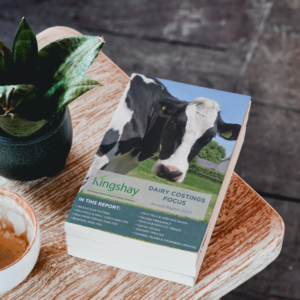
Positive trends for dairy herds despite challenging conditions
Dairy producers faced unprecedented volatility in 2022-23, with record high prices across the board, from inputs to milk markets. But they did an excellent job, securing record margins over purchased feed – although the gap between the top and bottom performers widened further, showing the importance of attention to detail.
According to the annual Kingshay Dairy Costings Focus Report, milk prices have increased by 61% over the past 10 years, reaching an average of 50.98p/litre in December 2022. However, there was a sharp drop in the first half of 2023, with prices losing more than they gained in the second half of 2022.
“The gap between the top and bottom 10% of prices reached a peak differential of 16.2p/litre in February, with producers in Scotland suffering the worst prices on a regional basis,” says Kathryn Rowland, senior farm services manager at Kingshay.
The hot, dry summer of 2022 caused milk from forage to drop slightly, with many producers turning to feed winter forage stocks. “The bottom 25% of producers used almost a tonne (917kg) more concentrate per cow than their higher performing counterparts, at 3,197kg fed over the 12 months.”
Not only did the summer impact yields, but fertility too. “Cows didn’t display such obvious oestrus cycles due to the hot weather. As a result, days to first service increased from 69 to 75, and given the high milk price, the cost of each day of extended calving interval increased to £5.89/day per cow,” says Ms Rowland.
When comparing production systems, year-round housed cows produced the greatest margin per cow (but this higher margin needed to cover higher costs of production associated with housing systems), with low to moderate yielding organic herds leading on a per-litre basis. “However, the gap between the top and bottom quartile of those within the same systems widened again, showing the potential to improve performance within an existing system rather than switching to an alternative,” she adds.
New to the report this year is heifer trends, which found 62% of herds were not hitting the age at first calving target of between 23 and 25 months. “Also, 50.2% of cows leaving the herd are in their first three lactations, before they have fully paid for the cost to rear them plus this can have a big impact on carbon footprints.”
Herd size has grown by 23% over the past 10 years, although there was a dip in 2019 to 2021 when flying herds were not restocking due to high heifer prices. “Since 2021, herd size has recovered its long-term trend, rising from an average of 201 cows to 217,” explains Ms Rowland.
Yields have also grown by 10% over the past decade, but over a shorter period have stagnated, remaining around 8,400 to 8,450 litres per cow since 2020. “This could be due to a reduced focus on production alone, with a shift towards efficiencies and margins,” she adds.
Milk from forage and grazing has also remained static since 2020, but over 10 years has grown by 31% and 9%, respectively. At the same time, concentrate use per cow has grown by 12%, with prices up by 46% to a record high of £357/t (rolling 12 month average). As a result, total purchased feed costs have jumped by 58% per cow and 44% per litre of milk produced.
“Thankfully, the milk price has increased by 61% over the same period – also to a record high – meaning the milk price to feed price ratio has widened by 10%, to 1.33,” says Ms Rowland. “The larger the ratio, the better it is for farmers – and last year was the highest it had been since 2018.”
The 10-year trend looks positive when it comes to the bottom line. “The average margin over purchased feed improved by 86% on a per cow basis, and 69% on a per litre basis, to £2,865 and 33.87p/litre, respectively – their highest levels since Kingshay first started the costings service back in 1998. A much needed additional margin to cover increases in all the non-purchased feed input costs,” says Ms Rowland.
Close attention should be paid to cost of production for the next 12 months, to assess the impact of high input costs, with accurate budgets essential for planning cash flow. “Margins over purchased feed continues to be a key way to easily monitor production, feed efficiency and feed costs, along with milk quality and price each month, with comparisons to similar herds.”
Download your free copy of the Dairy Costings Focus Report at www.kingshay.com or visit Kingshay at the UK Dairy Day on 13th September or The Dairy Show on 4th October.
Editors’ notes
Kingshay is an independent livestock specialist based on a commercial dairy farm in Somerset. It specialises in providing independent and practical support to farmers and the wider industry throughout the UK, based on its own trials and investigations.
Over the years, Kingshay has developed bespoke tools for organisations across the agricultural industry. This includes the UK’s leading dairy costings service Dairy Manager and the Dairy Insight Service, which enables farmers to measure and monitor real farm performance, benchmark against others, and gather the latest international research and information to improve efficiencies.
Kingshay is part of the VetPartners farm group, which includes leading veterinary practices across the UK.
Download your free copy of the Dairy Costings Focus Report here or visit Kingshay at the UK Dairy Day on 13th September or The Dairy Show on 4th October.
